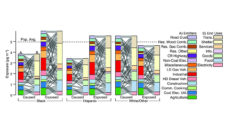Shipping is indispensable for the global economy — about 90% of trade is carried by marine transportation — but it is also one of the world’s highest polluting sectors. By burning fossil fuels, 15 of the biggest ships belch more noxious pollutants — primarily in the forms of sulfur dioxide, nitrogen oxides, and particulate matter — into the air than all the cars worldwide. Ships usually burn the heaviest sulfur-laden “bunker” fuel made from the dregs of crude oil to power their travel and consume diesel fuel to generate onboard electricity while at berth in ports.
Because 70% of the shipping sector’s emissions occur within 250 miles of coastline, marine ships are major contributors to urban air pollution in coastal and inland riverside cities, such as Los Angeles and Pittsburgh. Hence, people living or working adjacent to ports — 39 million in the United States — face severe health risks, including premature mortality and increased incidences of respiratory, cardiovascular, and lung diseases.
To address these public health concerns, policymakers have taken actions to slash emissions from the waterborne transportation sector, such as limiting the sulfur content of marine fuels regulated by the International Maritime Organization (IMO). Electrifying ships at berth and associated port activities (e.g., short-haul trucks and cargo handling equipment) has been extensively discussed as a way to curb local air pollutant emissions and improve human health. This policy allows berthed ships and port equipment to plug into the onshore electric grid and to use electricity generated at distant power plants as the power source.
Our results shed light on how electrifying the shipping sector can be a vital piece of the puzzle in larger-scale efforts towards deeper decarbonization, decreased emissions, and improved public health.
In a recent study, we estimated the long-run environmental and economic impacts of electrifying ships in and near ports in the United States out to the year 2050. We specify three progressively ambitious scenarios representing different electrification levels. The first scenario assumes electrifying auxiliary power for vessels in ports using grid power. In the second scenario, we assume electrifying auxiliary and primary vessel engine fuels within 200 miles of the shoreline through both grid power and additional electrified tugboats. The last electrification scenario is the most ambitious one, assuming that all fuels burned by vessels in the United States are electrified (e.g., perhaps through technologies like onboard electric storage). As policymakers and analysts increasingly focus on deep decarbonization, we also investigate these electrification scenarios coupled with economy-wide carbon pricing.
Our main finding is that local air pollutant emissions from waterborne transportation can decrease by 8-65% under the electrification scenarios by 2050. The reductions account for any emission increases from power plants to generate the electricity used by the ships. In addition, we also find modest net carbon dioxide emission reductions from port electrification. An ambitious electrification scenario coupled with carbon pricing can achieve even higher emission reductions.
These potential decreases in local air pollutant emissions from port electrification have enormous public health benefits. We show that the social and other benefits from avoided premature mortality outweigh the costs of implementing electrification for US ports. The social benefits are primarily clustered in coastal and inland river regions such as cities with large seaports (e.g., Houston and Los Angeles) or along the Mississippi river (e.g., Memphis).
Our analysis has important policy implications. So far, only 16 ports in the United States are electrified for marine ships at berth. And, outside of California, no federal or state policies regulate port pollution through electrification. Our results shed light on how electrifying the shipping sector can be a vital piece of the puzzle in larger-scale efforts towards deeper decarbonization, decreased emissions, and improved public health.
Photo via Getty Images















